By Seth Mercer on Sep 16, 2022 10:28:27 AM
🏈 I'm certainly ready...football season has firmly taken hold in my household. My son is a high school freshman this year, so that means weekends of college and pro ball on TV are sandwiched between kicking off the weekend under Friday night lights and junior varsity games at the outset of the week. As an offensive tackle, my son’s job is to protect one of the team’s most valuable assets; the quarterback. If the pass rush is breaking through the offensive line, the QB, the play, and the whole drive may be at risk.
On a conveyor system, one of the most valuable assets is the belt itself. It’s the most expensive part of the system therefore, protecting it from risk and harm should be as important as protecting your star quarterback.
A belt that gets battered, gouged, ripped, and torn is going to struggle to effectively and efficiently keep the drive alive and move its load forward. It’ll begin mistracking and running out of bounds while fumbling cargo and spilling material on the sidelines. As these problems compound, it puts the entire team at risk of injuries and penalties. Things can get downright ugly and quickly out of hand, making it hard to dig yourself out once you’ve fallen so far behind.
One of the simplest and most effective, yet often overlooked or underappreciated, ways to protect your belt from harm is to keep lumps of material from sneaking through on the return side of the belt and wreaking havoc as it lodges between the face of the tail pulley and the belt. Once caught between the pulley and belt, this material can puncture, tear, and abrade the belt. This surface damage creates the opportunity for fine material to become embedded in the outer layers of the belt, eventually building up and packing onto idlers and rollers contributing to material spillage and belt mistracking.
So, what’s the most effective scheme to ensure the health and safety of belts? Let’s crack open the  and analyze three options—good, better, and best—for a winning strategy.
and analyze three options—good, better, and best—for a winning strategy.
 a free copy of our Belt Conveyor Playbook featuring comprehensive gameplans for system operations & maintenance to help your team score wins for safety & productivity!
a free copy of our Belt Conveyor Playbook featuring comprehensive gameplans for system operations & maintenance to help your team score wins for safety & productivity!
Wings & Wraps
No, I’m not shifting this football-themed analogy to tailgate chow or the halftime smorgasbord; the pulley itself can act as a last line of defense. Winged pulleys and spiral-wrapped pulleys offer alternatives to standard steel drum pulleys as they attempt to move material away from the belt to avoid damage.
Good, Better, & Best
Good: Winged Pulleys
Wing pulleys feature vanes that resemble the paddle wheel on a steamboat. This design allows material that would otherwise become trapped between a solid pulley and the belt to pass through the pulley face. Valley-shaped recesses between the pulley’s crossbars provide a self-cleaning function; there’s little surface area on which material can accumulate, and the rotation of the pulley throws the material off the pulley’s face.
.png?width=450&name=wingpulley%20(2).png)
Despite the design's intention, wing-type tail pulleys are still subject to buildup and entrapment and often do not provide the desired protection. Larger lumps of material can become wedged in the wings of the pulley, potentially causing the very damage the pulley was designed to avoid.
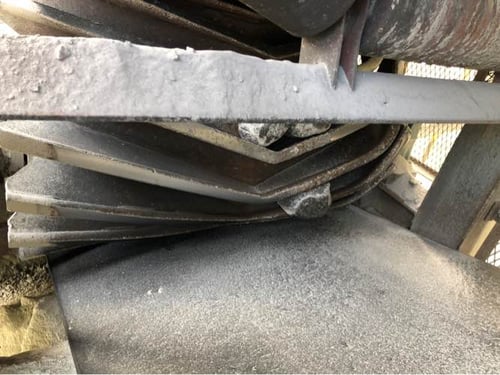 The most significant drawback is the oscillating action introduced to the belt path. The wings on the pulley introduce a pulsating motion that destabilizes the belt path and adversely affects the belt sealing system. It’s counterproductive to design a transfer point game plan that emphasizes belt stability to minimize fugitive material and then install a winged tail pulley that introduces instability into the system.
The most significant drawback is the oscillating action introduced to the belt path. The wings on the pulley introduce a pulsating motion that destabilizes the belt path and adversely affects the belt sealing system. It’s counterproductive to design a transfer point game plan that emphasizes belt stability to minimize fugitive material and then install a winged tail pulley that introduces instability into the system.
Better: Spiral-Wrapped Pulleys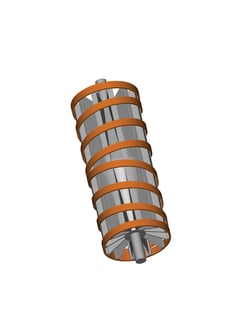
A better choice than the conventional winged tail pulley is a spiral-wrapped tail pulley. These have an additional steel strip wrapped in a spiral around the pulley circumference. The steel band is wrapped over the top of the wings in two spirals, converging in the center from each end of the pulley. The bands of steel allow the pulley to provide the self-cleaning function but eliminate the destabilizing “bounce” imparted to the belt.
Tail Protection Plows
Best: V-Type and Diagonal Plows
The best solution to preventing material buildup on tail pulleys is to stop the material from making contact with the pulley in the first place. A solid, flat steel pulley protected by a cleaning device located directly in front of the pulley ensures the most effective means of belt protection.
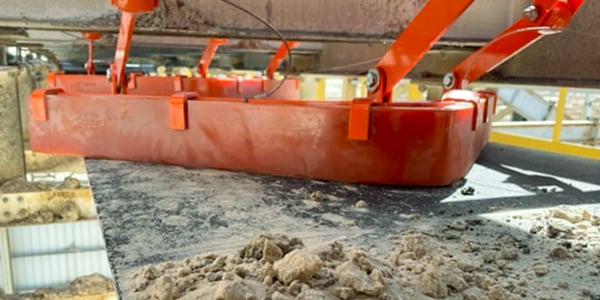
A  or
or  protection plow removes fugitive materials with a simple, low-pressure scraping that directs the material away from the belt much like a snowplow cleans a road. Instead of cleaning fines off the belt, the primary mission of a plow is to block any large lumps or stray conveyor components, such as idler rollers, belt cleaner blades, or other tramp iron, from entering the tail pulley where they can damage the belt.
protection plow removes fugitive materials with a simple, low-pressure scraping that directs the material away from the belt much like a snowplow cleans a road. Instead of cleaning fines off the belt, the primary mission of a plow is to block any large lumps or stray conveyor components, such as idler rollers, belt cleaner blades, or other tramp iron, from entering the tail pulley where they can damage the belt.
A plow that is installed slightly above the belt has the potential to capture a lump of material against the belt and, therefore, risks surface abrasion and damage with the possibility of ripping the belt. Pulley protection plows are usually designed to float on the belt’s surface, using either the weight of the plow or a tensioning mechanism to hold the plow with slight pressure against the belt. These heavy-duty plows are tall enough to keep fast-moving materials from going over the top of the plow.
A quality, reliable plow should:
- Provide firm but flexible pressure
Firm but flexible pressure will allow the device to clean the belt surface. The intent of the device is to remove material effectively and efficiently yet adjust automatically to accommodate for the wear of its blade and fluctuations in belt movement, speed, and path. - Be securely mounted
The plow must be firmly mounted in order to minimize the risk of it breaking away and endangering the conveyor components it was installed to protect. The installation should include a safety cable to protect the conveyor system should the plow installation fail. - Be designed for ease of installation
The plow should be easy to install to minimize downtime during the installation procedure. For example, the device should fit within the conveyor structure without requiring extensive modifications to the device or the structure. - Be designed with a durable, easily replaceable blade
In order to provide a long service life and allow fast maintenance, the blade should be fabricated of a material suited to withstand application conditions, and it should be attached so it can be easily removed and replaced when worn. - Be readily accessible
The plow should be installed in an area where it can be observed during operation and easily maintained.
As you are watching football this season, I hope you remember the importance of protecting the belt.

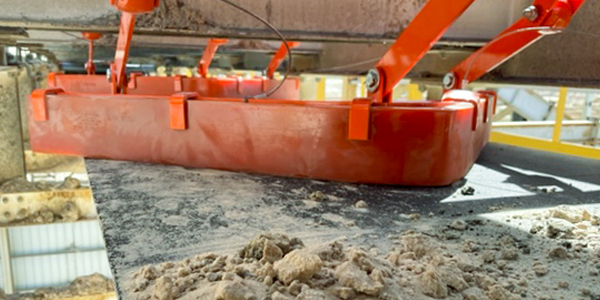

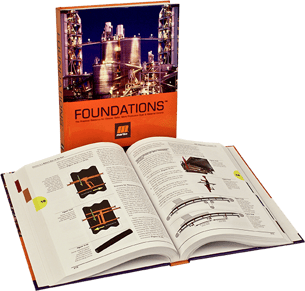

comments